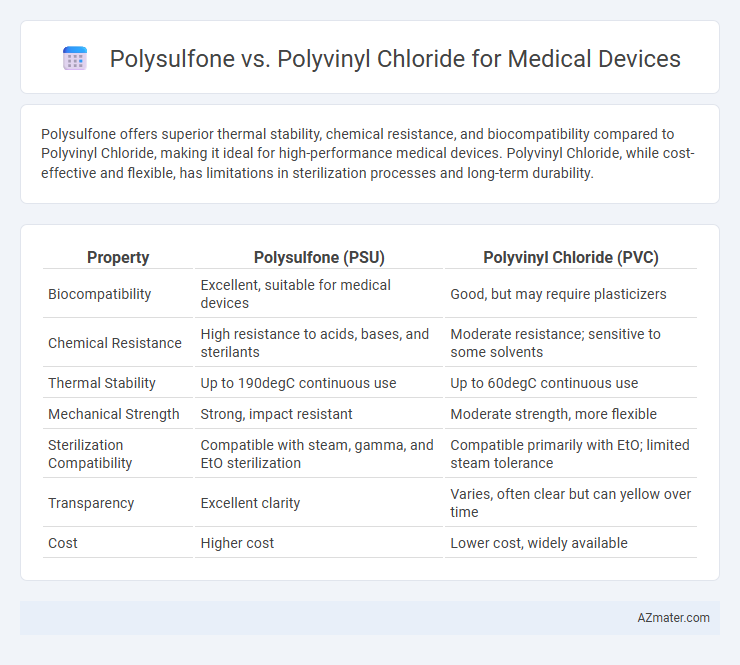Polysulfone offers superior thermal stability, chemical resistance, and biocompatibility compared to Polyvinyl Chloride, making it ideal for high-performance medical devices. Polyvinyl Chloride, while cost-effective and flexible, has limitations in sterilization processes and long-term durability.
Table of Comparison
| Property | Polysulfone (PSU) | Polyvinyl Chloride (PVC) |
|---|---|---|
| Biocompatibility | Excellent, suitable for medical devices | Good, but may require plasticizers |
| Chemical Resistance | High resistance to acids, bases, and sterilants | Moderate resistance; sensitive to some solvents |
| Thermal Stability | Up to 190degC continuous use | Up to 60degC continuous use |
| Mechanical Strength | Strong, impact resistant | Moderate strength, more flexible |
| Sterilization Compatibility | Compatible with steam, gamma, and EtO sterilization | Compatible primarily with EtO; limited steam tolerance |
| Transparency | Excellent clarity | Varies, often clear but can yellow over time |
| Cost | Higher cost | Lower cost, widely available |
Introduction to Medical-Grade Polymers
Medical-grade polymers such as polysulfone and polyvinyl chloride (PVC) are extensively utilized in medical devices due to their biocompatibility and mechanical properties. Polysulfone offers excellent thermal stability, chemical resistance, and transparency ideal for sterilizable components, while PVC provides flexibility, durability, and cost-effectiveness for tubing and disposable medical supplies. Choosing between polysulfone and PVC depends on application-specific requirements including sterilization methods, chemical exposure, and mechanical stress tolerance.
Overview of Polysulfone (PSU) and Polyvinyl Chloride (PVC)
Polysulfone (PSU) is a high-performance thermoplastic known for its exceptional mechanical strength, thermal stability up to 160degC, and excellent chemical resistance, making it ideal for sterilizable medical devices such as dialysis membranes and surgical instruments. Polyvinyl chloride (PVC) offers versatility with flexible formulation options, cost-effectiveness, and biocompatibility, frequently used in disposable medical items like tubing, blood bags, and catheter components. Both materials balance durability and safety, but PSU typically outperforms PVC in long-term use and high-temperature sterilization environments.
Chemical and Physical Properties Comparison
Polysulfone exhibits superior chemical resistance to acids, bases, and sterilizing agents compared to polyvinyl chloride, making it ideal for medical devices that require repeated sterilization cycles. Physically, polysulfone offers higher thermal stability with a glass transition temperature around 185degC, while PVC typically softens near 80degC, limiting its use in high-temperature applications. The enhanced mechanical strength and clarity of polysulfone provide significant advantages in precision medical components over the more flexible yet less durable polyvinyl chloride.
Mechanical Strength and Durability
Polysulfone exhibits superior mechanical strength and durability compared to polyvinyl chloride, making it ideal for medical devices requiring robust performance under stress. Its high tensile strength and excellent resistance to heat and chemicals ensure longevity and reliability in sterilization processes. Polyvinyl chloride offers moderate mechanical properties but is less durable over time, especially when exposed to repeated cleaning and sterilization cycles.
Biocompatibility in Medical Applications
Polysulfone demonstrates superior biocompatibility compared to polyvinyl chloride (PVC) in medical device applications due to its exceptional chemical stability and resistance to hydrolysis, minimizing leachables and ensuring patient safety. PVC often requires plasticizers, which can leach out and trigger adverse biological reactions, making it less ideal for long-term or implantable devices. The inherent thermal and oxidative stability of polysulfone supports sterilization processes without compromising material integrity, enhancing its suitability for critical medical applications.
Sterilization Methods and Resistance
Polysulfone demonstrates superior resistance to high-temperature sterilization methods such as autoclaving and steam sterilization, maintaining mechanical integrity and dimensional stability, whereas Polyvinyl Chloride (PVC) is more susceptible to deformation and degradation under these conditions. PVC is compatible with low-temperature sterilization techniques like ethylene oxide and gamma irradiation but may release harmful plasticizers, raising biocompatibility concerns. The choice between polysulfone and PVC in medical devices hinges on the required sterilization protocol and the necessity for durability, chemical resistance, and patient safety.
Cost Analysis: PSU vs PVC
Polysulfone (PSU) typically incurs higher material and production costs compared to polyvinyl chloride (PVC) due to its superior thermal stability and chemical resistance, which enhance device durability and sterilization capabilities. PVC offers a cost-effective option with lower raw material expenses and easier manufacturing processes, making it favorable for disposable or single-use medical devices. Cost analysis must consider lifecycle expenses, with PSU providing long-term savings through reusability and compliance with stringent regulatory standards, while PVC benefits from widespread availability and lower initial investment.
Environmental and Regulatory Considerations
Polysulfone (PSU) offers superior environmental stability and higher resistance to sterilization processes compared to Polyvinyl Chloride (PVC), which often contains plasticizers like DEHP that pose environmental and health concerns. Regulatory agencies such as the FDA prefer polymers with lower toxicity profiles, making PSU more favorable in medical devices requiring repeated sterilization and long-term biocompatibility. PVC's environmental impact is heightened by challenging recyclability and potential chlorine-based emissions during production and disposal, whereas PSU's thermoplastic nature supports easier recycling and reduced toxic byproducts.
Common Medical Device Applications
Polysulfone is widely used in medical devices requiring high heat resistance and sterilization stability, such as dialysis membranes, surgical instrument housings, and respiratory device components. Polyvinyl chloride (PVC) is favored for flexible medical tubing, blood bags, and catheters due to its excellent chemical resistance and cost-effectiveness. Both materials provide biocompatibility but differ in mechanical properties and sterilization compatibility, influencing their application in various medical device categories.
Choosing the Right Polymer for Your Medical Device
Polysulfone offers superior thermal stability, chemical resistance, and biocompatibility compared to polyvinyl chloride (PVC), making it ideal for high-performance medical devices requiring repeated sterilization and long-term durability. PVC remains a cost-effective choice, favored for single-use applications due to its flexibility and ease of processing, although it may pose concerns related to plasticizers and potential leachables. Selecting between polysulfone and PVC hinges on device-specific requirements for mechanical strength, sterilization methods, and patient safety standards.

Infographic: Polysulfone vs Polyvinyl Chloride for Medical Device
 azmater.com
azmater.com